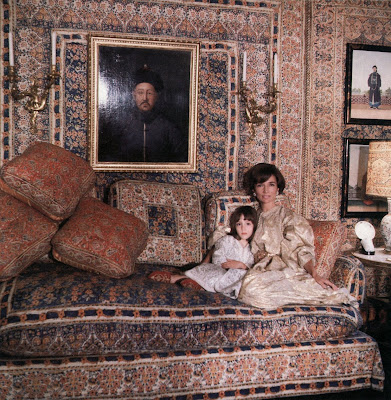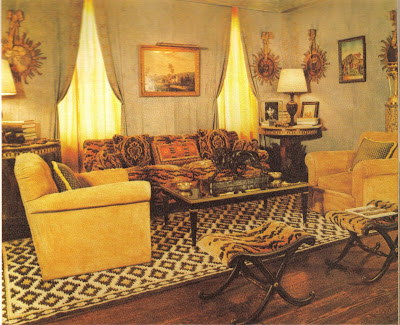
It goes without saying that many people have long been fascinated with Jackie Onassis- no surprise there. But Jackie's sister Lee Radziwill is also a style icon, albeit one who still stands in the shadow of her more famous sister. Certainly Radziwill is known for her keen fashion sense, but she seems to be quite confident in how she chooses to live (I'm talking about the actual interiors of her homes- NOT her personal life!) .
Through the years, her homes seemed to reflect the zeitgeist of interior design. Remember her wonderful Renzo Mongiardino designed drawing room from the 1960s? That said, her interiors have also had a classic quality to them. Many photos of her homes are hard to date which to me is the ultimate compliment.
I've found some images of both her country home in England as well as her Fifth Avenue apartment. Radziwill was a decorator for a time, so I believe she was responsible for her New York interiors. I'm not sure who decorated her English country house- possibly Renzo Mongiardino? If anyone can clarify, please do so!
The dining room of Radziwill's country house Turville Grange c. 1971. The walls were covered in Sicilian scarves that had been lacquered. Painted panels were superimposed over the scarves. If this was not designed by Mongiardino, it certainly looks it. (Photographer Horst P. Horst)
The garden room of Turville Grange certainly had an English country house feel, but some of the furniture gave it a modern twist. (Horst, photographer)
The front hall at Turville Grange, again c. 1971 (Horst, photographer)
The dining room of Radziwill's Fifth Avenue apartment, c. mid-1970s. The walls were covered in silk moire. Don't you think the Regency dining chairs and pedestal table are stunning?
I think this is one of my favorite rooms in Radziwill's New York apartment. The walls of the library were covered in blue-gray fabric, which was also used for the curtains. You can't really see any delineation between the window treatments and the walls.
The drawing room was also a vision in red.
Image above: That famous photograph of Radziwill and her daughter in their Mongiardino designed drawing room.
Monday, June 30, 2008
Lee's Timeless Design
Thursday, June 26, 2008
Thoughts on Tassels

After going through some old clippings recently, I realized that there are a few things that always seem to catch my eye. And one thing that stops my magazine page- turning cold is the sight of a tassel. Truly, I haven't figured out why because I only have one tassel in my home. (Believe it or not, I do try to keep the embellishments to a minimum!) Still, they're fun and a bit frivolous. Here's a brief roundup of these little flights of fancy.
Smith & Brighty Rainha Tassel
Tassel beach blanket by Madeline Weinrib
Agraria perfumed tassels, available at Charlotte Moss
Vintage Tassel Table from Mecox Gardens
Tassel sconces from Brunelli Designs
Gilt Bronze and Opaline Jardiniere from Heather and Company
"Garland and Tassel" wallpaper border by Adelphi Paper Hangings
Image at top, courtesy of Conde Nast Archives
Tuesday, June 24, 2008
Who Influenced Who?

Have you ever noticed how many designers have made their mark on the design world by creating gorgeous brown rooms? And not just any brown, but a deep, dark, and sometimes glossy brown. David Hicks, Billy Baldwin, and Vay Day Truex are just a few of the designers who have created stunning (and legendary) brown rooms- rooms that still serve as inspiration today.
But what I want to know is who jumped on the brown bandwagon first. And who influenced who?
Van Day Truex seemed to lead the way with his gorgeous brown living room, designed in 1951. Truex was a style setter, so I wonder if he influenced Billy Baldwin's enthusiastic and masterly use of glossy brown. After all, when you think of glossy brown walls, don't you immediately think of Baldwin's Manhattan apartment:
So, was Truex responsible for Baldwin's affinity for brown? Or was it in fact Mrs. Walter Farwell, a friend of Ruby Ross Wood who designed a Coromandel lacquered room in her home that captivated Baldwin, at least according to his memoir Billy Baldwin Remembers :

And what about David Hicks? Hicks' living room with its Coca-Cola lacquered walls has a bit of an American look to it. Might he have been emulating some of his American counterparts? I have a feeling that had Hicks been influenced by American designers, he would not have divulged this information:
Albert Hadley has used glossy brown throughout his career. He freely admits that he was greatly influenced by the design greats such as Truex (a close friend) and Baldwin. Not only is Hadley a genius, he's a gentleman too:
And what about Sister Parish's living room circa 1968? Was she solely responsible for the choice of glossy brown walls? Or, was she testing out Hadley's more modern aesthetic:
And the cycle continues... Miles Redd chose glossy brown for one of his early projects. He has cited Hadley as having an impact on his style, so are we seeing that here?
Monday, June 23, 2008
English Exuberance

The English are masters of the eccentric look (I'm referring specifically to interiors, but many Brits have proven to be eccentric dressers too). And despite the notion of the British "stiff upper lip", they can also be an exuberant people. British history is filled with grand homes and estates that displayed a vibrancy and an enthusiasm that was uniquely their own.
Whereas our American ancestors might have been tempered by their Puritan roots, many members of the British upper class did not seem constrained by such humility. To me, one of the most exuberant British houses was Brighton Pavilion, that wild and lavish fantasy commissioned by George IV while he was Prince Regent. While many of the Prince Regent's contemporaries ridiculed the Pavilion (and let's face it- many of the rooms are a bit, well, should we say tacky?), perhaps old George had the last laugh. The Pavilion is still standing, still beckoning visitors, and continues to influence interiors, albeit on a smaller scale, around the world.
And while the British were ardent fans of Chinoiserie, they also displayed an eagerness to embrace other styles as well. Here are a few colorful examples:
The Peacock Bedroom at Sezincote, the early 19th century home designed by Samuel Pepys Cockerell in the Mughal style.
The Gallery at Syon House, home of the Duke of Northumberland. Robert Adam was responsible for the glorious interiors of the house.
A bed designed by Robert Adam as a Temple of Venus, c. 1775-76. Located in the State Bedchamber at Osterley
The State Bedchamber at Kedleston Hall. The bed was built in the late 1760s.
Recognize this room? It's the Gothic bedroom at Haseley Court, Nancy Lancaster's country home. The bedroom was a collaborative effort between Lancaster and John Fowler.
Image at top: The Banqueting Room at Brighton Pavilion
Tuesday, June 17, 2008
Lighting Millinery

Before I left home for college, my mother warned me about mixed drinks and alcoholic punches- too much and I might end up with a lampshade on my head. Well, I heeded Mother's advice and thankfully got through school without any major embarrassments. But after seeing these lamps by mat&jewski, I say bring on the Hunch Punch! I'm ready to wear these lampshades.
Now, I'm not really a fan of flouncy or cutesy lamps and shades. And despite the whimsy of the mat&jewski lamps, they unfortunately would not work in my home. But I just couldn't help but think of those great feathered hats that women used to wear. You know, women like Doris Day, Audrey Hepburn, and the like. Maybe it's time for feathered millinery to make a comeback. And you can start with one of these lamps at your next party. Just don't say that my mother and I didn't warn you about the punch.








All lamps by mat&jewski; vintage fashion photos from Conde Nast Archives; images of mannequins with feathered hats by Stephen Jones.
Monday, June 16, 2008
Paying Homage to the Past

Have you ever noticed how Chinese ancestral portraits seem to grace many stylish interiors? Once I spotted them in one interior, it seemed that I started to see them everywhere. Of course, the paintings found in the interiors below were used strictly for decorative purposes, and I can certainly see why. There is something very dignified and regal about these portraits, and they also seem to add a little touch of Eastern exoticism to their surroundings. But what we shouldn't forget is that the purpose of these paintings was anything but decorative.
Ancestral portraits were long an important part of a Chinese culture which revered and worshipped family ancestry. From what I've read, it seems that these paintings were commissioned by family members not just out of respect for their forebears, but also out of fear. A disgruntled ancestor might be tempted to become a ghost and make life difficult for the living. In order to prevent this from happening, and to elicit good will and fortune, the portraits were worshipped by family members either in their homes or at family temples. Ceremonies, which at times included offerings to the ancestors as well as kowtowing, were often performed before these portraits.
So with this in mind, here are a few of the interiors that I have found which display these ancestral portraits. In a way, it seems that even today these portraits still command respect and awe, much as they did centuries ago.
(If any of you are experts on Asian art and wish to add to this, please do so by commenting- I would love to learn more about these portraits.)

Frances Elkins used them in a few of her projects, including one of her most famous: the library of Mr. and Mrs. Kersey Coates Reed. I think the portrait looks smashing against the Hermes goatskin paneled wall.
Jean-Michel Frank tried his hand at stage design in this set from "Les Fleurs des pois". The Chinese portrait rather dominates the set.
Yves Saint Laurent was obviously a fan.
Here are a pair of Chinese ancestral portraits in a contemporary setting- the living room of Liz and Steve Weinstein, decorated by Miles Redd (photo from Elle Decor; photographer Simon Upton)
Image at top: A pair of ancestor portraits, c. 1700-1800. From the collection of the Victoria and Albert
Wednesday, June 11, 2008
Thoughts on Stripes

I have always adored Dorothy Draper's living room. Those bottle green stripes are beyond snappy! (Image courtesy of Condé Nast Archives)

A striped room by Anne Coyle. I love how the stripes are reflected in the mirrored cocktail table.

Miles Redd used one of his favorite striped fabrics for the walls of this living room. (I know, you've seen this room a million times before, but it's still gorgeous!)

How smashing is this bar in the home of designer Sam Blount? The black and white stripes mixed with red curtains and flowers is bold and snazzy.

My, oh my! Are these some stripes or what? Here, the stripes are railroaded rather than vertical. Although a bit too gutsy for my tastes, I just had to show you this photo. (Design by Melvin Dwork, whose work I do like!)
Photo at top: A Dorothy Draper designed room at the Arrowhead Springs resort. Unfortunately, I don't know if the stripes are pink and white or blue and white.







